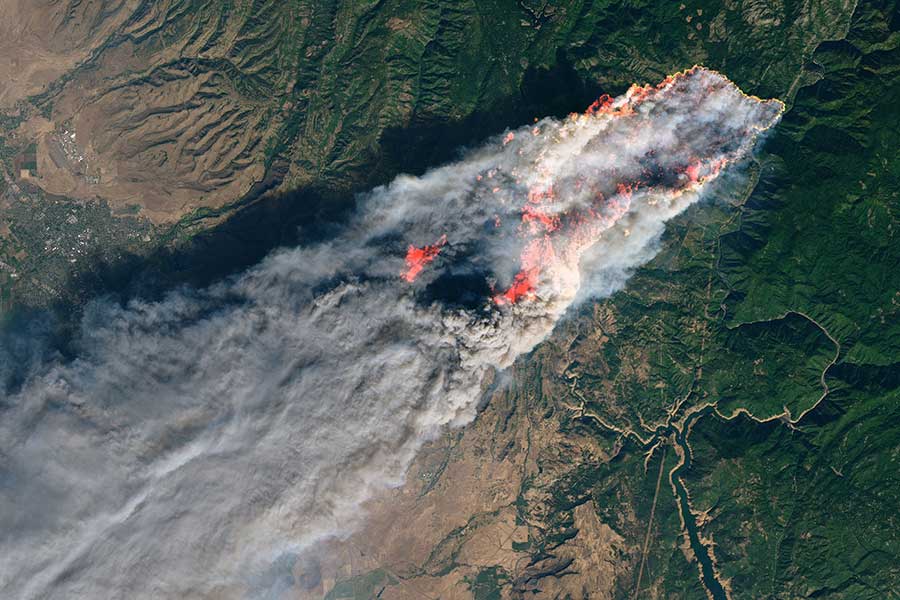

Source: The University of Nevada, Reno
Moved by the tragedy of the 2018 Camp Fire, a team of engineers and scientists are coming together in a new five-year project to develop a comprehensive, holistic, computational live, digital platform to predict and monitor wildfire risk that can be used by wildfire managers, emergency responders and utility companies to plan for, respond to and remediate wildfires.
With a background and expertise in computational modeling in civil engineering, Hamed Ebrahimian, from the College of Engineering at the University of Nevada, Reno, began pursuing a better way to understand fire risk. He assembled a multi-institutional group of researchers with a similar desire to use science and technology to reduce the chances that the world would suffer from another wildfire of the Camp Fire magnitude.
With a five-year, $2 million grant from the National Science Foundation’s LEAP-HI program, the research project envisions an eventual live, digital platform that evolves with new data and dynamically updates the long-term (seasons/months ahead) to short-term (weeks/days ahead) pre-ignition fire risks at regional and community scales for risk management, and the post-ignition fire behavior at near-real-time (hours-days) for situational awareness.
“This is an interdisciplinary intervention with a diverse team to blend different thinking modalities and to build a digital platform that can be used to monitor the risk of wildfire on a spectrum of spatial resolution and time,” Ebrahimian said. “Once developed, the computational platform will increase the efficiency of the wildfire management process by providing timely actionable information to decision-makers.”
The initiative brings together atmospheric scientists, civil engineers, information systems and technology, fire ecology, weather systems, structural and fire engineering, and computer-vision and machine learning. The team will create and integrate transdisciplinary scientific knowledge and techniques in the fields of data harnessing (collection, processing, fusion, and uncertainty quantification), computational modeling (wild- and urban-fire initiation and spread, as well as social quality-of-life models), stochastic simulation, and model-based inference.
“This can help reduce the risk of fires but the risk can never be eliminated,” Ebrahimian said. “Our objective is to develop a systematic framework to quantify the risk of wildfires to wildland-urban-interface communities in terms of the total probability of loss. Loss is defined as a combination of monetary damage and the change in the quality of life of people.
“The risk, thus, depends, on one hand, on the characteristics of the community, its structure, and location and, on the other hand, on the wildland and the factors affecting the fire ignition and spread, such as topography, climate conditions, fuel type and moisture. Now, we want to have the capability to combine all these factors and predict the seasons-month ahead to weeks-days-ahead risk for different communities and regions.”
The team of researchers assembled by Ebrahimian includes:
- Adam Watts, associate research professor in fire ecology at the Desert Research Institute, will contribute his expertise in fire surveying and data collection using unmanned aerial systems;
- Branko Kosovic, director of the Weather Systems and Assessment Program at the Research Applications Laboratory of the National Center for Atmospheric Research, will lead the NCAR effort on assessing wildland fire risk assessment;
- Negar Elhami-Khorasani, assistant professor in the Department of Civil, Structural and Environmental Engineering at the University at Buffalo, will develop a data-driven urban fire spread model to evaluate risk of wildfire in wildland urban interface communities;
- Ertugrul Taciroglu, professor and chair of the civil and environmental engineering department at the UCLA Samueli School of Engineering, will lead the development of advanced tools that will make use of computer vision and machine-learning techniques to extract terrain and fuel characteristics from satellite and drone data;
- Amir Talaei-Khoei, associate professor in the College of Business, will extend the engineering approach of the team to a humanistic perspective. His main goal is to understand the underlying effects of wildfire on the quality of people’s lives, including their perception about their individual and social viabilities; and
- Neil Lareau, assistant professor in the Atmospheric Sciences program of the Department of Physics, will lead the effort to collect real-time data on wildfire plumes and fire progression using state-of-the-science scanning lidars and radars.
Community Engagement
“We are looking forward to work with the broader fire community to exchange knowledge and tune the research outcomes toward addressing the existing pain points and technical gaps,” Ebrahimian said. “Our objective is to have a practical, adoptable and useful technology framework, and for this, we welcome any collaborative efforts.”
The project will involve eight graduate students and one post-doctoral scholar in a convergence research environment, training the next generation of transdisciplinary experts and researchers on wildfire hazards. A new joint educational curriculum between the civil engineering and physics departments at the University of Nevada, Reno is planned to train the future workforce in wildfire engineering. The project includes an educational outreach program that will target local schools through University K-12 outreach programs. Lesson modules will be developed about wildfires, which will highlight the important roles of STEM research in developing novel solutions to emerging problems.
“This project exemplifies the engineering spirit. Through collaboration, it provides multiple lenses for understanding a pressing problem not only in the United States but around the world. It advances our common goal of protecting lives and increasing prosperity. Because it integrates essential educational components, it further ensures that the next generation will build on its successes,” University of Nevada, Reno College of Engineering Dean Manos Maragakis said. “We are proud of Hamed and his exceptional collaborators, and we are grateful for their contributions to our global community.”
More: https://www.unr.edu/

